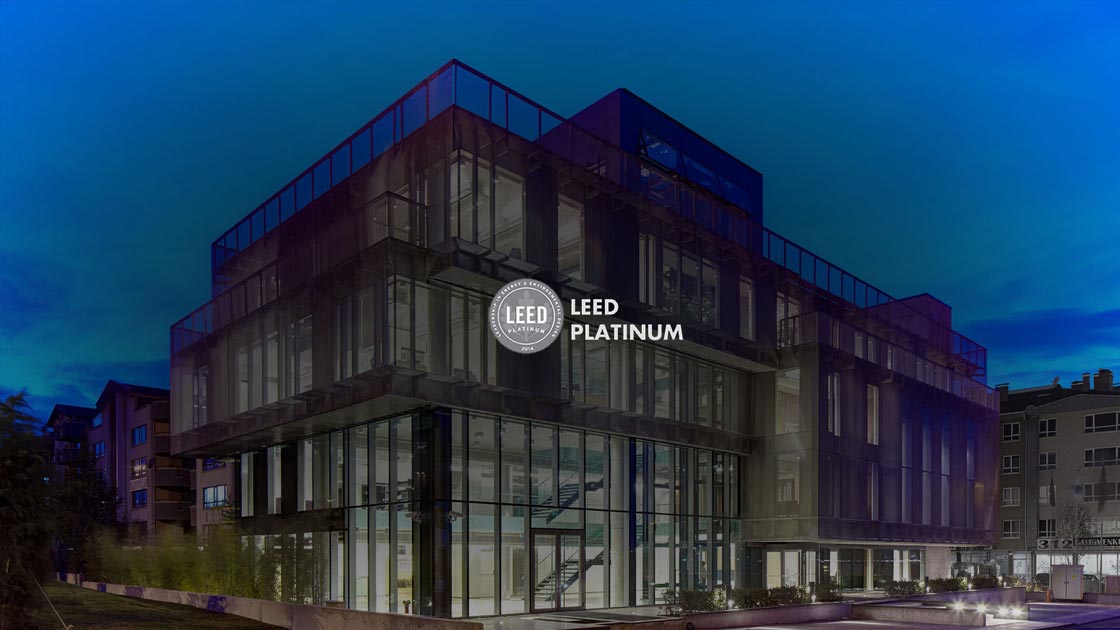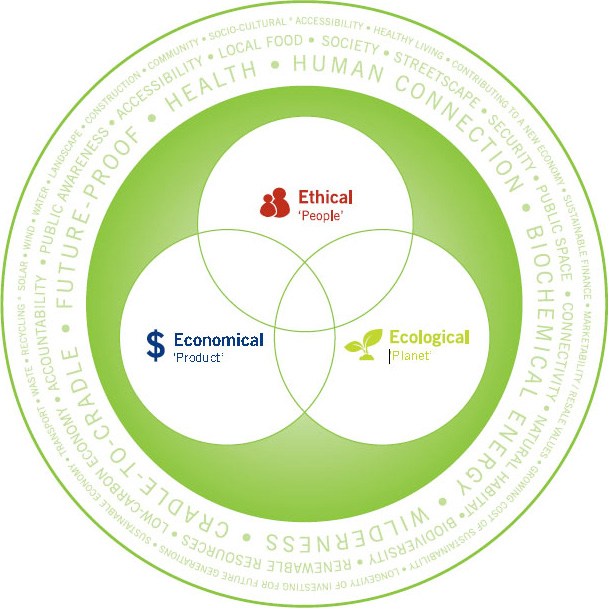The Economic Dimension of Sustainability
LEED certified buildings value $1700 more per square meter
The occupancy rates of LEED certified buildings are 4 percent more…
As one of the leading figures of sustainable architecture in Turkey, the founder of Avcı Architects, Selçuk Avcı, provides energy efficiency in buildings up to 50 percent due to the ecological implementations of his design proposals. Turkish Architect Selçuk Avcı asserts that the ratio reserved for the green buildings within the entire activities of companies is 13 percent in 2009 and 28 percent in 2012, whereas the expectation of this ratio for 2015 is at least 60 percent. He continues to argue that there is a 4 percent increase in the occupancy rates of the LEED certified buildings in the United States in comparison with the non-certified ones and the sale price of the certified buildings is $1700 more per square meter. In that sense, Turkey is believed to exhibit similar rates soon.
Avcı Architects, an awarded company both in national and international realms developing architectural designs based on principles of sustainability, provides nearly 50 percent energy saving on account of climatic and economic solutions developed in green building designs. Selçuk Avcı, the founder of Avcı Architects, carries green building technologies one step further through a number of ecological implementations employed in Turkish Contractor’s Association HQ, which is granted with the LEED Platinum Certificate and the International Project of the Year in Building Awards 2014. Being the first building in Turkey that uses thermal labyrinth system, TMB performs nearly 50 percent energy efficiency as compared to conventional buildings and as a consequence of these qualities it continues to conduct Turkish construction industry.
The sale price of LEED certified buildings is $1700 more per square meter…
Selçuk Avcı, the founder of Avcı Architects operating in London, İstanbul and Ljubljana in a range of fields like architecture, interior design, exhibition and stage design and also the former vice president of ÇEDBIK (Environmental Friendly Green Buildings Association) argues that at present sustainability does not only imply recycling, but also is associated with alternative materials and construction techniques, technological developments and anticipated energy
statistics in design phases. Avcı further claims that the economic aspects of design process, which have considerable importance for the architect and the investor, should be assessed within the framework of sustainability. According to Selçuk Avcı, the ratio of economic potential of the construction systems that promote recycling within the market continuously expands. Correspondingly, as specified by the World Green Buildings Trends Report published by the British engineering and consulting firm McGraw Hill Construction in 2013, the ratio reserved for the green buildings within the entire activities of companies is 13 percent in 2009 and 28 percent in 2012, whereas the expectation of this ratio for 2015 is at least 60 percent. Drawing attention to the commercial advantages of sustainable buildings, Avcı states that:
“American based company CoStar Group’s investigation in 2008 proves that there is a 4 percent increase in the occupancy rates of the LEED certified buildings in the United States in comparison with the non-certified ones and the sale price of the certified buildings is $1700 more per square meter. Another survey conducted by Northwest Multiple Listing Service based in the United States clarifies that eco-friendly houses in Seattle are sold 24 percent faster than the conventional houses and they offer 5.9 percent more bounty.”
Low energy and zero emission buildings should be designed…
As manifested by Selçuk Avcı sustainable building design should not only be associated with green building fashion. It is believed that constructional implementations may be improved through an in-depth investigation of the data specific to the design process and the use of local sources. In that respect, Avcı asserts that: “sustainability should be analyzed in three major domains, namely ethical, ecological and economic. In order to refer to a sustainable product, these three spheres should be integrated into the process. The ecological domain and its driving forces are already widely known. It is not difficult to define the economic dimension of sustainability. A building can only be specified as sustainable, if its economic value transcends contemporary conditions and embraces future scenarios in order to meet the requirements of future generations. Therefore, as concluded by Selçuk Avcı, it is necessary to underline the fact that real-estate investments are actually long-term investments.”
Considering the arguments of Selçuk Avcı, it is inevitable to focus on the design of low energy and zero emission buildings, since along with technological developments sustainability is believed to promote efficiency both in the production and the user phases of the building:
“According to the data derived from International Energy Agency, it is necessary to reduce the carbon emission of the constructions designed by using the prevalent technologies by 33 percent until 2030. This ratio is expected to be between 50-85 percent by 2050. If the outcomes of global
warming are ignored and economic precautions are not taken in this regard, it is anticipated that the Gross Domestic Product will be between 5-20 percent. This means the investment cost of the reduction of carbon emissions of new constructions to desired levels is expected to be 1 percent of international Gross Domestic product.”
Selçuk Avcı affirms that by using “passive house” principles, a number of EU countries like Germany, Switzerland, Austria design zero carbon emission buildings that save up to 95 percent energy and by 2019 it is claimed that the execution of this procedure will be obligatory in all EU countries. The consequence of this situation is the production of 20 times more energy and zero emission buildings in comparison with Turkey. Underlining the necessity to augment the usage of solar panels in order to benefit from sun, the major energy source of sustainable buildings, Avcı further adds that it is critical to maintain the balance between energy production and consumption.
“According to global warming reports, due to global warming, the economic loss may rise up to 1 trillion dollars in 20 years, whereas the necessity to cope with the situation is 200 billion dollars. Therefore, Avcı advises to take this data into consideration and re-asses the prevalent implementations in Turkey.”
The use of renewable energy sources and the consumption of energy consciously save 1,2 billion Turkish liras per year…’
While claiming that it is essential to consider sustainability not only at building scale, but its relationship with economy should also be evaluated, Selçuk Avcı draws attention to the investigation of Energy and Heat Efficiency Association (ETADER), which argues the possibility of saving 1,2 billion Turkish liras through the consumption of energy consciously and the usage of renewable energy sources in approximately 2 million houses that have central heating system. Avcı emphasizes that Turkey should take critical actions with respect to its policies about production and consumption of local resources, since three quarters of the total energy consumption of Turkey is still being imported and this value increases continuously. In this regard, energy efficiency has to be considered in global scale rather than singular buildings. In accordance with data presented in the Energy Report of Turkey in January 2015:
“The balance of energy in Turkey between 1990 and 2013 proves that the principal energy demand increased 127.39 percent and the import augmented 211.62 percent, while the increase in local production is only 24.78 percent. In addition to these, the import of energy goods is $54.785.000.000 in 2014, whereas the average cost of import is expected to reach $59.874.000.000 per year between 2015-2017.”
In response to these data, which are, in fact, tragic at local scale, the architect Selçuk Avcı underlines the necessity of restructuring the energy policies to maintain the dialectics between energy efficiency and sustainable economy in Turkey and also focuses attention on promoting such investments. According
to the previously mentioned report scrutinizing our local and renewable energy resources, only 1-2 per thousand of solar energy is used for electrical production, while the electrical production capacity of Turkey by use of solar energy is 400 milliard kWh per year, which is, in fact, one and a half times more than the consumed electricity in 2014. Besides, Avcı further argues that 80 percent of the energy consumption of a residential unit is actually heating and cooling energy and it is quite essential to consider the significance of the additional cost, 500 Turkish Liras, per house in terms of energy efficiency, since the energy consumed to cool a space is 3 times more than heating the same area.
Why is the struggle against global warming not on the agenda of political domain?
As emphasized by the architect Selçuk Avcı, it is significant to discuss the transforming and restructuring aspects of “sustainable development” and the attempts to reproduce the consumed natural resources not only within singular architectural productions, but also within the political context. In that respect, besides architects, economists and ecologists, politicians should also put the issue of sustainability on their agenda, while bringing its potentials about protection and transformation, self restructuring, the holding capacity of earth and the adjustment of buildings into focus.
Similar to the project of sending human to the moon through the collaboration of world’s developed countries during Cold War period of the United States, a group of scientists envisions a project dedicated to the problem of energy, which would be financed by all countries. The project, which is entitled as “Global Apollo”, suggests the reservation of the 0.02 percent of the Gross Domestic Product of each country for clean and cheap energy production. During the cold war period, the United States sent human to the moon by organizing all scientists together. As manifested by Selçuk Avcı, now it is time to make the same attempt for the solar energy. These kinds of projects were proposed in the past as well, yet they were not realized. At the moment, there is no reason to ignore such proposals. The global data is the proof of the seriousness of the future situation. The 2 degrees centigrade increase of average global temperature values by 2035 means the retreat of glaciers and the rise of water 20 to 30 centimeters in a number of regions. As a consequence, the risk of flooding will threaten various cities like İstanbul and changing climatic conditions will result in further disasters. It is not an option to ignore the situation and do nothing about it at the present.
Focusing the attention on the seriousness of the global warming and the associated disasters, Selçuk Avcı defines sustainability as their principal approach, which is actually prominent in relation to active and passive energy systems implemented in buildings, water and waste management, cooling, heating, lighting systems, interior air quality, emissions and the long term profits of the building as well as the living quality. Within this contextual framework, urban emissions that harm the ecological equilibrium, the production of impermeable surfaces, the destruction of farming zones, river basins and forests are in direct relation with local authorities and they are major issues that destroy the ecosystem at urban scale. While concluding, Avcı manifests that the investigations about global warming is at the core of sustainable development. It is essential to discuss sustainable development principles within the political context in search of factual solutions.





